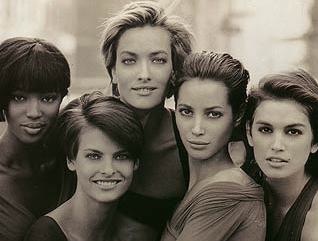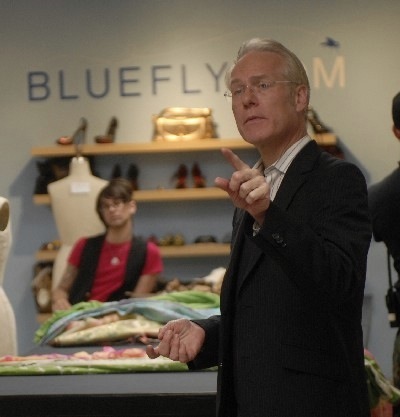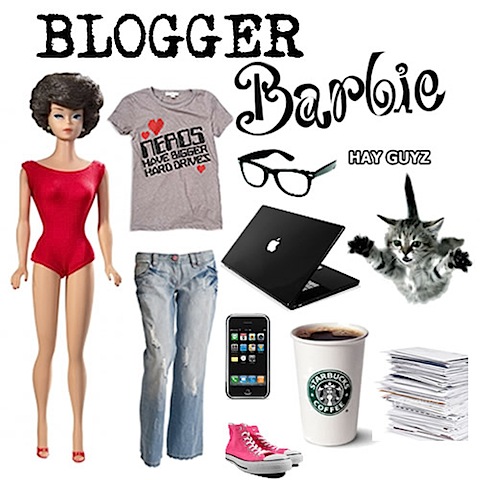I’m not sure whether Naomi, Linda, Tatiana, Christy, or Cindy are really on Twitter, but if they are, their strategy probably involves one of five “supermodels” of Twitter participation.
[Yes, that’s what we call a bait ‘n switch, but since you’re more interested in Twitter than in Supermodels, you don’t really mind, right?]
If you know anything about supermodels — and let’s face it, you probably do — you know that everybody from Andre Leon Talley to Cindy Leive to Mark Morris has his or her own idea of what constitutes a ‘supermodel’.
In the real world, it actually doesn’t matter what criteria you use, as long as you get the right types for your own personal catwalk. 
The same is true on Twitter. Just like everybody has his or her pantheon of “Supermodels” (Claudia, in or out?), folks have different ways of parsing the roles people create for themselves on Twitter. You can choose from among these typologies the roles that work for you.
(“But don’t Social Media and Fashion clash?” you ask. Only for those who lack a sense of adventure. I am going to “make it work”. Tim Gunn told me to.)
Here are my personal favorite 5 Supermodels of Twitter.
These five models organize what’s fashionable, and show you how to work it.
1. Tamsen McMahon at ‘Round the Square shows how Trust Agents can rock twitter.
Chris Brogan and Julian Smith defined Trust Agents, and McMahon sorted Trust Agents into 5 different models explaining how Trust Agents add value. It turns out that, with Tamsen’s models, Trust Agents translate to Twitter much better than fashion models translate into actors. The 5 models include:
- The creator. The person who creates new ideas. The generator.
- The connector. The person who connects ideas, and /or people, together.
- The filter. The person who analyzes and prioritizes ideas for redistribution. Their value comes in their ability to pick out the “good stuff.”
- The interpreter. The person who translates ideas between groups, including from current groups to ones that don’t yet exist. The teacher.
- The collector: The person who aggregates information, sorts it for reference of the others, and often help provide backup (in the form of data) for others’ work. These are librarians, of sorts, whose value comes in their ability to provide both comprehensive and easy-to-use high-quality information.
2. Deirdre Breakenridge organizes her Twitter models into a “relationship stairway”,
considering not the content activity of her Tweeple but rather the level of engagement and relationship she’s creating with them.
- The Casual Friend: “Casual conversations can also equate to bigger opportunities including interviews, great blog posts and overall really good information that could only come from a simple “Good Morning” on Twitter.”
- The Taker with Good Info: “Takers” can be good Tweeple. ” Casual friends often turn into those who begin to share information with me, in hope that I will discuss it further with my community.”
- The Giver: “The Giver is a special friend. This person doesn’t ask anything of you, they simply find you interesting and naturally want to share your information with their friends…Meaning and value to both parties may lie ahead.”
- The Giver and Taker Friendship: Where the relationship becomes equally balanced and both sides feel a great deal of benefit.”
- The Trusted Confidante: ‘Someone who you will trust with sacred information. …They have your best interest at heart, as you have theirs. This is your trusted advisory board on topics and information that you couldn’t find as easily or as readily available, if it didn’t stem from a Twitter conversation.”
3. Jeff Hurt’s got a developmental model,
where we become better Tweeters once we figure out what we can offer… and then settle into it. His “Big Tweet Theory”:
- Phase 1 – The Birthing Announcement: Hello Twitter. Look what I can do.
Tweeting “seems new, odd, fearful, fun, stupid and exciting.”
- Phase 2 – Sharing The Blue Bird’s Kitchen Sink: Here’s everything that’s happening.
“Their tweet flood overwhelms many that are following them.”
- Phase 3 – Restraint And Insight: Communicating the good stuff
“(T)weets contain links to more detailed (info), additional resources and provocative thoughts. Followers begin to realize that their missing out on great education and networking.”

4. From the world of Journalism, via Jay Rosen, Mike Masnick at TechDirt
considers how journalists might take different roles-– and these too look like models for Twitter:
- Reporters — who go out and do first person reporting — creating original stories, not just reposting rewritten wire copy.
- Columnists — who “start conversations and give stories another perspective.”
- Curators — who “‘cover’ the news by sorting, verifying and editing live everything good existing on the web and in the media. They make link journalism, they make the news more accessible.”
5. And advised by Rohit Bhargava,
You can have an ‘attitude’ about your own place on Twitter. Even if you are a neophyte, you can consider yourself to be (or to be-coming) one of 9 Types of Social Media Experts
- The Pretender
- The Trainer/Teacher
- The Professional Speaker
- The Content Curator
- The Event Organizer
- The Community Manager
- The Content Creator
- The Marketing Strategist
- The Designer/Builder
What do you do with all these different styles, models, fashions?
Think about what’s up for you this ‘season’. Take a look at some of these different collections. Try on some of these other ways of thinking about what we’re all doing on Twitter (and elsewhere on social media).
See if there might be a few more Twitter styles to add to your wardrobe. Make it work, even better, for you.
See you on the runway Twitter.
4.1.10
 I am an organizational consultant, change advocate, and organizational identity/reputation scholar with a PhD in leadership & organizations. I research, write about, and consult with organizations on the relationships between organizational identity, actions, and purpose. I teach Technology Management, part-time, at Stevens Institute of Technology.
My current research focuses on how social technologies in the workplace can drive organizational change, generate meaning, and catalyze purpose. See the
I am an organizational consultant, change advocate, and organizational identity/reputation scholar with a PhD in leadership & organizations. I research, write about, and consult with organizations on the relationships between organizational identity, actions, and purpose. I teach Technology Management, part-time, at Stevens Institute of Technology.
My current research focuses on how social technologies in the workplace can drive organizational change, generate meaning, and catalyze purpose. See the 
{ 5 comments }
Wow, thanks for including me in such a great list of who’s who Twitterati here. Chris, Julien, Deirdre, Jay, Mike and Rohit all have great ideas and concepts about becoming a super model on the Twitter Runway.
.-= Jeff Hurt´s last blog ..14 Adult Learning Principles To Combat The Conference Learning Crisis =-.
Just a quick point of clarification–the five types you mention as part of Chris and Julien’s book weren’t actually part of “Trust Agents”–I came up with those after reading the book. I’m glad you like them!
.-= Tamsen McMahon´s last blog ..Brands, the Universe, and Everything =-.
Tamsen,
thanks so much for alerting me to my error. So much for just pasting text into Evernote…made it too easy to misattribute the post to B/S instead of you!
I hope that the revision, above, captures your contribution more effectively.
Also, your reviews of Trust Agents are really useful, so readers should go find them here: http://www.sametz.com/roundthesquare/posts/2010/01/best-of-09-trust-agent/
cv
Fascinating and helpful as always, C.V. I’m excited to try out some new looks!
Wow, CV, I love the way you’ve compared the social media “space” – and in particular Twitter style – to fashion and modelling. I’ve sat reading through this for a while trying to identify my own style and then another thought struck me. It was that I should try to think, not just what my style IS, but what it OUGHT to be to best support my business. I’d love to see how these different styles would overlay something like the competing values framework, if you’re familiar with it?
.-= Christine Livingston´s last blog ..How To Use The Turning Of The Seasons To Support Your Development =-.
Comments on this entry are closed.